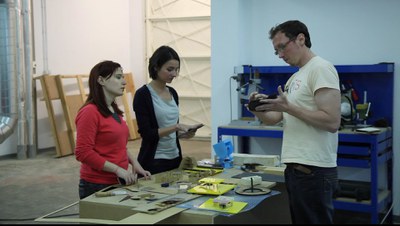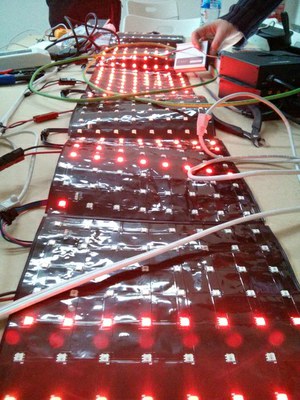The author as a producer: Fab labs
What can I learn/create in a fab lab? The history of fab labs, Spanish examples and what artists working with new media think about their usefulness
By Marta Lorenzo Jaudenes,(@MartaLorenzoJ)My Art Diary
It is more than obvious that the arrival and implantation of new technologies in our lives has impacted the way we communicate, which is increasingly virtual, resulting in a new modus vivendi that, of course, has also influenced the artistic field fostering the development of new forms of production. Now more than ever we can say that we are post-humans or even cyborgs –borrowing this concept used by Donna Haraway in her Manifest for Cyborgs (1995), that has been adopted by feminist activism on the Internet since the 1990. New technogies have re-started the old Benjamin’s dream of the author as a producer or the incorporation of the artist into the productive fabric of society, or at least, in theory. We must try to implement this theory and introduce it from education.
As part of this process that intends to foster curiosity, creativity and, especially, critical thinking, AuLAB was founded as an innovation project carried out by LABoral, Centro de Arte y Creación Industrial. Roughly, its main goal is fostering critical reflection upon the role of new technologies in the context of education, changing the relationship of students and teachers from pasive users of these technologies to active –and, why not, proactive- experts. In the following link you can see the open online platform that compiles and documents the evolution and experiences of teachers and students in this project.
The so-called Fab Labs started at the beginning of this century along this same line of fostering knowledge and supporting creativity focusing on research. They were born as a network of local labs at the initiative of the Center for Bits and Atoms of the MIT (Massachusetts Institute of Technology). Their mission is to enable any individual to access digital fabrication tools, thus opening the way for the individualisation of production. The existing global network of fab labs, with labs in over 30 countries such as United Kingdom, Iceland, France, Germany, Japan, India or Chile makes it possible to share not only documentation, but especially experiences, thus building one of the world’s largest distributed knowledge networks. You can see its reach in this map provided by Román Torre, on this same blog in his post What is a Fab lab? What is going on in there?. The facilities or equipment available in these production spaces are, in general, computer-controlled machines to produce physical objects from digital designs, and to design and create electronic tools and devices.

Manufacturing process developed at FabLAB Asturias
The most important examples in Spain are the Fab Lab of Barcelona, the Fab Lab of Valencia, MediaLab-Prado and FabLAB Asturias of Laboral. The latter hosts starting next November 10 the sixth edition of the Introduction course on the use of the FabLAB. The use of tools such as cutting plotters, milling machines, laser cutters or 3D printers combined with different kinds of software enables not only artists that work with new media (as we might think at first), but also architects, designers, researchers or engineers to be acquainted with avantgarde design processes and manufacturing methods. The curious thing is that, for this course with 10 places, that usually registers full enrollment, no previous knowledge is required. Although this course is developed with software tools with or without licence (due to availability, convenience or standardisation), students are always encouraged to use free programmes like inkscape, librecad, freecad, openscad and, in general, in most workshops almost only open source software is used.
As David Pello, coordinator of fabLAB Asturias says: "With this course, students become fabLAB members for one year, this means that they usually come here to work with machines, to ask questions, etc, thus becoming active users and, therefore, they keep on learning. At the end of each course or workshop I always say that this is not actually the end, for the fabLAB is an open resource ".
An example of a fab lab, understood as an independent association, is the Makespace Madrid, a space located in the Spanish capital city that resulted from an initiative managed by a non-profit association, founded by the members of a community of technology and innovation developers. It offers the latest tools for prototype creation and development of creative and technological products and projects. The main feature and strength of this community is, without doubt, the collaborative production and the exchange of knowledge among its members. They work on fields such as 3D printing, electronics and open innovation processes. They take part in international events and workshops such as the Internet of Things Day and the Freedom Hardware Day.

Freedom Hardware Day. April 20, 2013. Makespace Madrid
I wanted to know first hand what is the actual use that artists working with new technologies think fab labs have, in particular, in the case of the fabLAB or LABoral. To this end, I have interviewed the collective Laramascoto, made up by Santiago Lara and Beatriz Coto, founding members of Makespace Madrid that live in Gijon, and also who else uses LABoral’s fabLAB. Their work results from the hybridation between techniques, merging the most primitive technique, drawing, with the latest technologies. This is what they have told me:
Are the resources offered by fabLAB Asturias useful?
Yes, very useful indeed, both the technical and the human resources. It is a space that, in addition to offering access to complex machines very costly for users, hosts seminars and workshops to learn how to use several devices. In addition this space generates community culture.
Is it a support as an environment for the relationship and co-creation with other artists?
We have worked specifically in a closed project where the experimentation was the technique itself, but there has been no cooperation or interaction with other artists. We are not aware to what extent collaborative work takes place at the FabLAB. What is indeed interesting is the fact that this space has highly qualified technical personnel, which enables artists who are not familiar with these tools to access them in an easy and effective way.
Would you recommend using it?
Yes, in particular for creators interested in new forms of production and new languages.
What would you improve?
The open-house days are a very interesting initiative where people can access the tools for free. It would be good to insist on this: Generating more meeting and collective learning spaces for users, in an OpenLab approach. It would also be useful to create active networks with public and private artistic institutions.
To wrap up I want you to see, in this video, a visual summary of what goes on in a fab lab, and I also leave you a reflection by Tomás Díez, responsible for the Barcelona fab lab.
"First we took production away to the industrial centres. Then we lost our ability to manufacture and now everything is made in China. We have arrived to an absurd situation where the only thing that we produce in cities is waste ".





